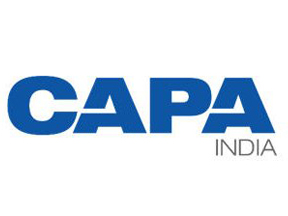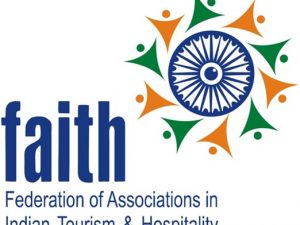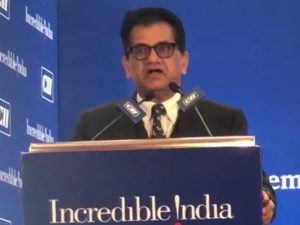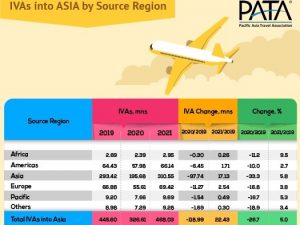`In its latest analysis on the impact of COVID-19 on the aviation industry, CAPA India has said that the government and industry will need to collaborate to rethink and redesign aviation sector to emerge from the crisis and move towards a sustainable future. The report explains, “The current crisis should be used to initiate structural changes for the long-term viability of the sector. The industry will need to make some hard choices. Airlines will need to restructure their businesses to become leaner and reduce costs, whilst also increasing the strategic deployment of technology and analytics to enhance revenue and improve efficiency.”
Read More »States & hotels should do joint promotions with agents to boost domestic tourism: PP Khanna
PP Khanna, President, Association of Domestic Tour Operators of India (ADTOI) during the 2nd TravTalk Digital Tourism Conclave said that it is important for states, hotels and travel agents to come together and do joint promotions for domestic tourism and boost it further. “Both states and hotels should look towards doing joint promotions with the travel agents to boost domestic tourism in India. M!CE is a big segment and according to 2018-19 data, this segment earned a revenue of Rs25,000 crore. With new ventures like banquet halls, trade fairs and facilities in cities like Delhi coming up, it is expected that by 2022, this revenue could double to the tune of Rs40,000-50,000 crore. All the states should consider opening new M!CE facilities.”
Read More »FAITH doubles its tourism loss estimates from Rs 5 lakh crore to Rs 10 lakh crore
Federation of Associations in Indian Tourism & Hospitality (FAITH) has revised upwards its loss estimation to Indian tourism. In a meeting, the association informed that it would like to revisit and double its earlier guidance. The earlier guidance which was calculated in March 2020 had put tourism’s economic value at risk at almost Rs 5 lakh crores from this pandemic. FAITH believes this value at risk could go as high as Rs 10 lakh crores given the way tourism supply chains are breaking down in India across all its key inbound, domestic & outbound markets. The direct and indirect economic impact of the tourism industry in India is approximately estimated at ~ 10% of India’s GDP. This roughly puts the full-year economic multiplier value of tourism in India at almost ~ Rs 20 lakh crores. This value covers the whole tourism value chain across airlines, travel agents, hotels, tour operators, tourism destinations restaurants, tourist transporters, tourist guides etc. These are across all the segments of tourism be they leisure ( inbound, outbound, domestic) corporate travel, heritage, adventure, meetings incentives, exhibitions & events, religious and spiritual tourism and in upcoming high-value niche tourism products such as sea & river cruises, camping, rafting, golf & film tourism, jungle tourism, agritourism and many more. Tourism has one of the largest economic multipliers. FAITH based upon its industry estimates believes, that in India given its globally unique natural and cultural heritage which is spread across the Indian hinterlands, each rupee spent on tourism could have an economic multiplier of between 2.5 – 3 times. While this is India’s global competitive advantage in tourism, this can also quickly translate into a competitive disadvantage due to …
Read More »Any product that is safe, reliable, and on time is luxury: Sanjay Kumar, IndiGo
With more than two decades of experience in aviation industry, Sanjay Kumar, Chief Strategy & Revenue Officer, IndiGo, has a different take on what luxury would mean in terms of air travel. “We believe that any product which is safe, reliable, on time, and affordable is luxury. If we can scratch even a two to three per cent of the total domestic market, and make air travel a part of their journey that would be great. Right now, these travellers are taking their own transportation, or trains, or buses. But if we can create an ecosystem for them which is cost-effective and efficient, that can help them travel the way they want to travel, then I think that can be called luxury too. Traveling by air itself is luxury. They have graduated from ground to air and if you have a network aligned to that in every state or tourist point, it makes for a great opportunity,” Kumar says, adding that Indigo has 63 destinations across the network of which 25-30 destinations have been launched in the last two years.
Read More »Tourism likely to undergo radical changes; domestic travel key in driving demand: Amitabh Kant, NITI Aayog
Amitabh Kant, CEO, NITI Aayog has said that tourism as a product is likely to undergo radical changes and the revival of domestic tourism, with necessary safety protocols, will be key in driving demand for future. Kant made this statement during the Empowered Group 6 meeting with representatives from tourism and travel industry to discuss the immediate challenges posed by the pandemic and way forward for the sector post COVID-19. Along with FAITH, its 10-member association representatives attended the meeting along with WTTC.
Read More »Goa might open for tourists post lockdown, provided air and rail connectivity returns
Goa might open for tourism after the lockdown gets over on May 17, it was revealed by Pramod Sawant, Chief Minister, Goa, has said that they will welcome tourists, provided the Central Government allows it. Speaking on the same, Nikhil Desai, Managing Director, Goa Tourism Development Corporation (GTDC) said, “Just like all the stakeholders, Goa Tourism is also eagerly awaiting normalisation of the current situation. The current priority is to fight COVID 19, However economic livelihood of the people is also extremely important. For a state like Goa, which depends overwhelmingly on tourism, it’s important that situation normalises at the earliest. We are looking forward to early commencement of tourism season.” However, when asked if it would be the first state to bounce back after lockdown, especially with no reported case of COVID-19, Desai, said, “Unfortunately, until and unless the situation in rest of the country stabilises and comes back to normal, Goa alone being COVID free cannot do much. After all we are banking heavily on domestic tourism to see us through this current season. All will depend on how fast the flights and rail connectivity returns to normal and only then we can expect a sizeable flow into Goa.
Read More »Hotel occupancy decline lowest in India among 5 key Asian countries: HVS
The recently-released HVS ANAROCK monthly newsletter titled ‘Hotels & Hospitality Overview’ reveals that among five key Asian markets – India, China, Malaysia, Thailand and Singapore – India had the lowest y-o-y decline in hotel occupancy for March at 52.9 per cent, while China witnessed the highest at 65.4 per cent. Malaysia, Thailand and Singapore witnessed occupancy declines of 64.7 per cent, 62.6 per cent and 53.6 per cent, respectively, for the said period. The report suggests that occupancies across hotels in key Indian cities witnessed a sharp decline, as travel restrictions intensified and India went into lockdown towards the end of March 2020.
Read More »Domestic tourists aged 18-35 will travel first; short-haul countries to pick up next: WTTC
The World Travel & Tourism Council (WTTC) has outlined what the ‘new normal’ will look like as countries begin to end their COVID-19 lockdowns and ease travel restrictions. As travel gradually returns to normal over the coming months, WTTC predicts that the first to return will be domestic markets with staycations, then to a country’s nearest neighbours before expanding across regions, and then finally across continents to welcome the return of journeys to long-haul international destinations. WTTC also believes that younger travellers in the 18-35 age group, who appear to be less vulnerable to COVID-19, may also be among the first to begin travelling once again. The tourism council also informs that new protocols and standards are being defined following feedback and multiple conversations with WTTC members, as well as collaboration from associations who represent the different travel sectors.
Read More »Hotels, travel agents can offer value proposition & unique experiences: Kerrie Hannaford
Kerrie Hannaford, Vice President Commercial, Accor (India & South Asia), says that hotels should work along with travel agents as they are experts in packaging the right products, and together they shall strive towards offering a value proposition and unique experiences to customers. Speaking at the 2nd TravTalk Digital Conclave, she said, “What we need to do collectively, with our consultants, is to become absolute experts in offering something unique and bespoke. There must be those ‘surprise & delight’ moments for our customers. The perception of value for money is going to be crucial. It is also important to know what unique experiences we can give to consumers, whether they are from the same city or have travelled from another end of the country. How the travel agent community helps us to establish that uniqueness is important, so that we can sell something to a consumer. As we step towards that level of recovery, that’s what people are going to want. They want to be able to ‘feel’ the value and it doesn’t matter whether it is a $50 hotel or a $100 hotel. They only want to ensure if they are getting that connectedness, that personalisation and as an industry, we need to come together and build that confidence for consumers.”
Read More »Asia to witness fastest visitor recovery when things resume; intra-region travel to herald growth: PATA
According to a newly updated forecast by Pacific Asia Travel Association (PATA), growth in international arrivals relative to 2019 figures is expected to rebound the fastest in Asia over the years to 2024. The release also suggests that this growth will be driven by intra-regional travel (Asia-to-Asia), with a rebound from a loss of almost 98 million arrivals between 2019 and 2020 to an increase of over 17 million between 2019 and 2021. All the source regions of Asia are projected to show growth between 2019 and 2021, with Europe and the Americas in particular, adding increases in arrivals of 2.5 million and 1.7 million, respectively over that period. By the end of 2021, Asia is predicted to have visitor arrivals numbering five per cent more than in 2019.
Read More » Tourism Breaking News
Tourism Breaking News









